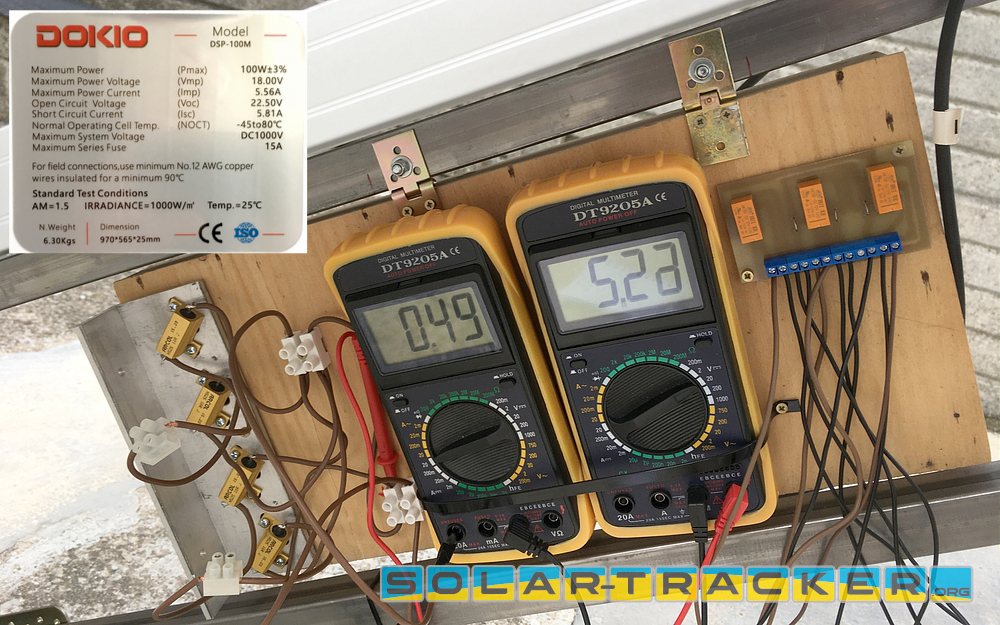Comparison of volts and amperes generated by fixed panel and mobile panel
Comparison fixed and mobile solar panel returns on our solar tracker - 12 hour test
For comparison we chose a solar panel with a low cost of size 970 x 565mm whose declared characteristics are: maximum power 100 Watts, maximum voltage 18 Volt and maximum current 5,56 Ampere, these declared data are only theoretical and not reachable in real conditions of use even on sunny days and with perfect orientation of the photovoltaic panel.
The purpose of the comparison, which has no scientific claim, was to have data measured in real and declared conditions, replicable by anyone instead of data obtained from tables, sometimes resulting from theoretical calculations or measurements in conditions and with undeclared instruments.
With such basis the only useful data of our interest is the difference that can be found in different times of the day in order to evaluate the entity and make us an idea of how convenient it is to use a solar tracker to have a better performance of our solar panels photovoltaic.
The test took place early September in northern Italy, measuring through 2 meters connected one as voltmeter and the other as ammeter the relative voltage and current levels generated by the solar panel.

[ With these simple components you can control the rotation of the solar panel Switch 1 on/off at each cam crest - 2 on only at end run ]
The structure of the solar tracker was directed so that the photovoltaic panel was perfectly perpendicular to the zenith point of the sun in a position to be considered as "fixed positioning of reference" or the position where a fixed photovoltaic installation has the highest efficiency, the position from which the voltage and current values will be detected in the various times inserted in the "fixed" column of the table below.
Four 25 Watt 10 Ohm armoured resistors mounted on a heatsink were used as load and connected in parallel for a total dissipating power of 100 Watt and resistance of 2,5 Ohm, with such a challenging passive load for not having ineffective measures it was decided a full sun day.
The test took place from 08.00am to 20.00pm with approximate current and voltage measurements for convenience at hourly intervals using the most appropriate step between the 28 available for the tracker and immediately afterwards bringing the panel in "fixed position of reference" to carry out such measurements even in a fixed position.
The data collected during the day are summarized divided hour by hour in the table below and as you can see more you move away from the zenith position where the values substantially coincide the differences in voltage and current are made significant in favor of the solar tracking system.
| Current and voltage values collected in the 12 hours YELLOW mobile solar panel GRAY fixed | |||||||||||||
| Time | 08.00 | 09.00 | 10.00 | 11.00 | 12.00 | 13.00 | 14.00 | 15.00 | 16.00 | 17.00 | 18.00 | 19.00 | 20.00 |
| Amp. | 0,79 | 1,18 | 2,8 | 4,75 | 4,11 | 5,32 | 5,21 | 4,89 | 3,77 | 2,89 | 1,5 | 0,47 | 0,09 |
| Amp. | 2,7 | 2,26 | 3,82 | 5,34 | 4,68 | 5,39 | 5,24 | 5,2 | 4,48 | 4,06 | 2,6 | 1,63 | 0,25 |
| Volt | 2,21 | 3,32 | 7,85 | 13,17 | 11,65 | 14,74 | 14,41 | 13,57 | 10,42 | 7,97 | 4,15 | 1,3 | 0,15 |
| Volt | 7,5 | 6,32 | 10,65 | 14,84 | 13,02 | 14,87 | 14,45 | 14,08 | 12,42 | 11,25 | 6,98 | 4,46 | 0,98 |
| Power dissipated in Watts on 2.5 Ohm test resistor hour by hour YELLOW mobile solar panel GRAY fixed | |||||||||||||
| Time | 08.00 | 09.00 | 10.00 | 11.00 | 12.00 | 13.00 | 14.00 | 15.00 | 16.00 | 17.00 | 18.00 | 19.00 | 20.00 |
| Watt | 1,74 | 3,91 | 21,98 | 62,55 | 47,88 | 78,41 | 75,07 | 66,35 | 39,28 | 23,03 | 6,22 | 0,61 | 0,01 |
| Watt | 20,25 | 14,28 | 40,68 | 79,24 | 60,93 | 80,14 | 75,57 | 73,11 | 55,64 | 45,67 | 18,14 | 7,2 | 0,24 |
With such data everyone will be able to make an idea if the realization of a solar tracker with features like ours is convenient from a cost/performance point of view; you can find our personal evaluations on the homepage in the chapter:
- Mobile solar tracker: situations where it can be useful and convenient -
NOTE: The returns as you will notice from the table data are not linear, that is, as the hours go towards the solar zenith the returns do not always grow because even if full sun day there may be light clouds or haze invisible to the eye but that do not escape the photovoltaic solar panel, which you could also check by connecting the panel with a load similar to our and tester on Volt measurement.
![]()
